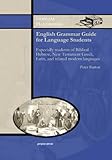English Grammar Guide for Language Students : Especially students of Biblical Hebrew, New Testament Greek, Latin, and related modern languages / Peter Burton.
Material type: TextSeries: Gorgias HandbooksPublisher: Piscataway, NJ : Gorgias Press, [2013]Copyright date: ©2013Description: 1 online resource (376 p.)Content type:
TextSeries: Gorgias HandbooksPublisher: Piscataway, NJ : Gorgias Press, [2013]Copyright date: ©2013Description: 1 online resource (376 p.)Content type: - 9781611438642
- 9781463233334
- online - DeGruyter
| Item type | Current library | Call number | URL | Status | Notes | Barcode | |
|---|---|---|---|---|---|---|---|
 eBook
eBook
|
Biblioteca "Angelicum" Pont. Univ. S.Tommaso d'Aquino Nuvola online | online - DeGruyter (Browse shelf(Opens below)) | Online access | Not for loan (Accesso limitato) | Accesso per gli utenti autorizzati / Access for authorized users | (dgr)9781463233334 |
Browsing Biblioteca "Angelicum" Pont. Univ. S.Tommaso d'Aquino shelves, Shelving location: Nuvola online Close shelf browser (Hides shelf browser)
Frontmatter -- Table of Contents -- Acknowledgments -- 1. Scope and Purpose of the Book -- 2. What is grammar? -- 3. Phrases and Sentences -- 4. Four types of simple sentences -- 5. Two parts of a simple sentence: subject and predicate I -- 6. Functions of words in sentences -- 7. Parts of Speech I -- 8. Two Parts of a Simple Sentence: Subject and Predicate II -- 9. Definition of a phrase -- 10. Transitivity of Verbs: Transitive verbs and intransitive verbs -- 11. Voice of Verbs -- 12. Tense of Verbs -- 13. Aspect of Verbs -- 14. Mood of Verbs -- 15. Summary of components of a simple sentence: one subject and predicate -- 16. Parts of Speech II -- 17. Case -- 18. Person -- 19. Number -- 20. Grammatical Gender -- 21. Tables of personal pronouns and pronominal adjectives III -- 22. Agreement I -- 23. Apposition: Words in apposition to nouns and pronouns -- 24. Types of Pronouns and Pronominal Adjectives I -- 25. Non-finite verbs -- 26. Grammar and Translation Issues II -- 27. Comparison of Adjectives and Adverbs -- 28. Phrases II -- 29. Simple sentence components and expansion using non-finite verbs and phrases -- 30. Clauses I: Clauses, simple sentences and composite sentences -- 31. Clauses II: Types of Subordinate Clauses (Dependent Clauses -- 32. Sentence Expansion II: step 4 -- 33. Conjunctions -- 34. Phrases III: Conjunctions and temporal phrases -- 35. Types of Pronouns and Pronominal Adjectives II -- 36. Agreement II -- 37. Distinguishing present gerunds from present participles in the active voice -- 38. Clauses III: Six types of Questions -- 39. Clauses IV: Direct and Indirect Speech -- 40. Word Order II -- 41. Parts of Speech Summary II -- 42. Summary of simple sentence components -- 43. Sentence expansion: adding clauses -- 44. Summary of Sentence Analysis Guidelines and Examples -- 45. A Difficult Example -- 46. Grammar and translation issues III: A basic rule of translation -- 47. Verbs with double objects Part II -- 48. Idioms using an indefinite pronoun or an indefinite adverb -- 49. Bibliography and Suggested Reading -- 50. Grammar Reference Glossary and Index
restricted access online access with authorization star
http://purl.org/coar/access_right/c_16ec
Too many incoming students are fluent in English but unable to discuss the language grammatically. Introductory language courses and textbooks often assume a proficiency and familiarity with grammatical terms that is not possessed by the students. This guide delivers an understanding of English grammar starting from simple concepts and presupposing no background or vocabulary. This book is designed as a textbook and a reference for students beginning a New Testament Greek, Biblical Hebrew, Aramaic or Latin course.
Mode of access: Internet via World Wide Web.
In English.
Description based on online resource; title from PDF title page (publisher's Web site, viewed 01. Dez 2022)









